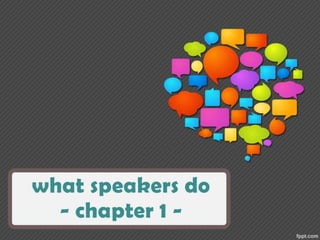
Pós-Graduação em Língua Inglesa Oral Practice
- 2. Pós-Graduação em Língua Inglesa Oral Practice – Professor: Raquel Oliveira Por: Rachel Moura Setembro/2012
- 4. introduction speech production conceptualization and formulation articulation
- 5. self-monitoring and repair automaticity fluency managing talking
- 6. The skill of speaking is complex and it involves: → a command of certain skills; → several types of knowledge; _______________________________________ Speech production, in the way of utterance (sentences), is linear and happens in real time. It relies on spontaneity.
- 7. •discourse type Conceptualization •topic •purpose •discourse Formulation •sintax • vocabulary
- 8. topic • what is talking about – matter → given information comment • what wants to say about the topic → something new
- 9. Pronunciation stress intonation (prominence) (pitch direction)
- 10. In the way of producing sounds, we use some organs. air Vocal lungs cords tongue teeth lips
- 11. conceptualization formulation articulation
- 12. • Planning time – input process formulation • utterances in a slow-down or pause or re-phrasing. • Expressing time – output process articulation • wrong word or pronunciation’s correction
- 13. Retrace Immediate -and- correction repair
- 14. fluency planning articulation Pre-fabricated chunks
- 15. speed Pauses (natural / unnatural) blocks syllabes
- 16. Speakers use some production strategies (tricks) pause fillers vagueness expressions repeats
- 17. Features of fluency pauses Occur at Words and May be Usually meaningful syllabes long, not filled transiion between frequent points them
- 18. • Interaction turns engagement
- 19. • The fundamental rule is that the speakers have to respect the other’s turn, not both speaking at once in fact. → Long silences must to be avoided; → listen when other speakers are speaking.
- 20. → recognize your turn time and the other speaker’s turn. → signalling when you want to say something and also that you’re listening to. → holding the floor when it’s your turn → yelding the turn
- 22. Gestures during the conversation (face-to-face) that confirm speaker’s intention.
- 23. On the phone, where we can’t see the other speaker’s face, expression, gestures, we have to rely on intonation, tempo and pausing, and still respecting the turn.
- 24. conceptualization formulation articulation self-monitoring
- 25. automaticity production strategies FLUENCY
